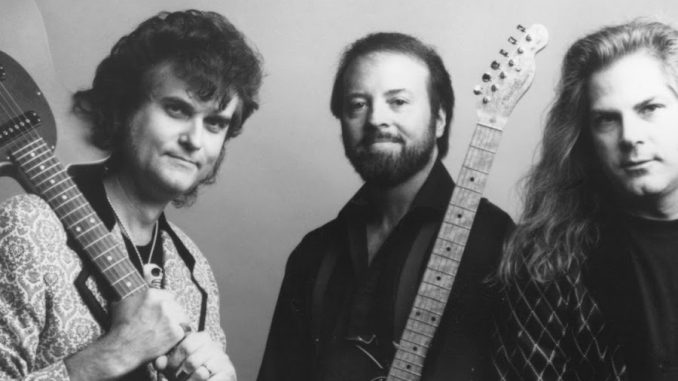
Having recently written about The Desert Rose Band in our ‘Whatever Happened To’ series it got me thinking about John Jorgenson and what he did after he parted company with Chris Hillman.
His next major project was, of course, The Hellecasters – the band that brought together three of the best Telecaster-style guitar players around at that time. The Telecaster guitar is, largely, accepted as being a Fender product but there are a number of other companies, most notably G&L, that build guitars based on the Telecaster style, as invented by Leo Fender. In fact, G&L is the company Fender went on to form in 1970 with George Fullerton, after selling his original Fender company to CBS in 1965. One of the interesting things about the Hellecasters is that, though they all play T-style guitars, only one of them regularly used a Fender Telecaster.
The legend has it that the twangtastic band came about following the 1988 production of an album, ‘Hollywood Roundup’ produced by renowned session guitarist, Will Ray. The album centred around musicians who lived in the Hollywood area at the time and one instrumental, credited to Candye Kane and the Super Pickers, featured Jorgenson and Jerry Donahue, alongside Jeff Ross and Billy Bremner. Will Ray remembered the session fondly and, when he ran into Donahue at the Palamino Club in 1990 they sat down together to watch the ensuing music. Jerry suggested it would be fun if they got together to play at an upcoming “open mic” at the same club. Will loved the idea but realised that, as with horn sections, they needed a third player, so that three-part harmonies could be achieved. The obvious choice was Jorgenson, given that they’d already worked together on that Super Pickers session. When Jorgenson got back from touring, Ray enlisted him and the two of them came up with the band name. Subsequently, the trio got together to arrange the short set and then brought in a rhythm section for an afternoon’s rehearsal. The rhythm section of drummer Steve Duncan and bassist John Davis were the preferred rhythm section for all the band’s work.
Will Ray was born in 1950 in Richmond, Virginia and started his musical career on the L.A session scene, working with, among others, Michael Nesmith, Joe Walsh, Steve Earle, and even Tom Jones and Thomas Dolby! He’s known for his use of a b-bender to create pedal steel sounds using a conventional electric guitar but, unlike the b-bender developed by Gene Parsons and associated with Clarence White, where the player pulls down on the strap, connected to a levered system via the upper strap button, in order to bend the B string, Will Ray uses the hip-shot system, where the bender is a lever attached to the guitar bridge and triggered by pulling the guitar across the body. His signature instrument, complete with Hipshot B-Bender and off-set pickups has long been produced by G&L.
Jerry Donahue was born in Manhattan in 1946, the son of a big band Sax player, Sam Donahue and his actress wife, Patricia. Donahue began learning guitar at an early age, initially looking to emulate the styles of guitarists like Duane Eddy and Chet Atkins but later being influenced by some of the great Telecaster players, including Danny Gatton, Albert Lee, and Clarence White.
Donahue moved to the UK when he was just fifteen and became fascinated by the folk-rock movement and is probably best known for his time with Fotheringay as well as a stint in Fairport Convention. Donahue is, generally, considered to be the second-best lead guitarist of the classic Folk/Rock period, behind the always lauded Richard Thompson – but it’s an unfair comparison given the different nature of their work. Donahue plays beautifully fluid and melodic music and has always been a musician serving the songs of others, rather than the force of nature that RT has become.
Donahue’s original signature Telecaster was made by the Fender Custom Shop but with a more affordable version built in its Japanese facility. Even the great Danny Gatton referred to Donahue as “the string-bending king of the planet” and this was the unique aspect he brought to the Hellecasters. His signature guitar features a Stratocaster pick-up in the neck position and a five-way switch for pickup selection, rather than the three-way usually associated with a Telecaster. In later years his signature guitar, always with the Stratocaster pick up and five-way switch, has been made by Peavey and, most recently, Fret King.
John Jorgenson, the “baby” of the band, was born in Madison, Wisconsin, in 1956. His mother was a piano teacher and his father an orchestra conductor and college music professor and Jorgenson himself has played professionally since the age of fourteen. The family relocated to Redlands, California when Jorgenson was just one year old.
Jorgenson’s signature Telecaster also originated in the Fender Custom Shop and came about while he was in the Hellecasters. The most immediately noticeable thing about Jorgenson’s signature guitars is the finish; they’re always a silver sparkle! They also feature special pick-ups that are, effectively, twinned single coils. These days his signature model is made by Fret King.
 It’s easy to see why The Hellecasters had such an impact when they first appeared. Three outstanding guitarists, each with their own distinct style of playing, each bringing a unique guitar personality to the mix. Mike Nesmith was in the crowd for a show by the band in April 1991 – their fourth appearance at The Palamino, their initial “Open Mic” performance having been so well received they’d already been back for two more sold-out performances. Nesmith immediately signed them to his record label, Pacific Arts. All three of their official albums, ‘The Return of the Hellecasters’ (1993), ‘Escape from Hollywood’ (1994) and ‘Hell 3: New Axes to Grind’ (1997) were released on the Pharoah label, one of Pacific Arts outlets. Their first album, ‘Return of the Hellecasters’ was awarded Guitar Player Magazine’s “Best Album” and “Best Country Album” awards in 1993.
It’s easy to see why The Hellecasters had such an impact when they first appeared. Three outstanding guitarists, each with their own distinct style of playing, each bringing a unique guitar personality to the mix. Mike Nesmith was in the crowd for a show by the band in April 1991 – their fourth appearance at The Palamino, their initial “Open Mic” performance having been so well received they’d already been back for two more sold-out performances. Nesmith immediately signed them to his record label, Pacific Arts. All three of their official albums, ‘The Return of the Hellecasters’ (1993), ‘Escape from Hollywood’ (1994) and ‘Hell 3: New Axes to Grind’ (1997) were released on the Pharoah label, one of Pacific Arts outlets. Their first album, ‘Return of the Hellecasters’ was awarded Guitar Player Magazine’s “Best Album” and “Best Country Album” awards in 1993.
With their blistering take on roots and country-rock music the band were popular with audiences from the outset, but the commitments to other projects for the three guitarists, all successful producers and session musicians in their own right, meant that finding time to record together and to commit to live performances was always an issue. Their third album wasn’t as well-received as the first two; coming a full three years after album number two it was recorded with the guitarists all having to record separately and sending their respective parts in to be assembled in the studio and this sense of separation came across on the album. They also struggled to convert a wider audience. Three great guitar players working together is always going to excite the guitar-playing fraternity but building a wider audience for the music, especially when by far the bulk of their recordings were instrumentals, was always going to prove difficult. Eventually, it seems, the band just ran out of steam as other projects took more and more time from the three guitar players. The third album, for the first time, contains tracks by individual players and really underlines the fact that this is a band starting to unpick a little at the seams. The band were always at their best when they played together, firing off each other as they swapped solos and just celebrated great guitar playing. Perhaps the track that best represents them, apart from their own ‘Hellecasters’ Theme’, is their version of the classic ‘Orange Blossom Special’ from the first album. The tempo just increases with every verse but the band stay in perfect sync and hardly even seem to be breaking sweat as the song cranks up to break-neck speed. Three great players at the top of their game, The Hellecasters had the sense to quit while they were ahead and still remain one of the great guitar bands of recent years.
Since the Hellecasters called it a day the three main protagonists have had their ups and downs. John Jorgenson was asked to work with Elton John in 1994 and ended up staying with the Elton John band for the next six years and this was one of the commitments that made the third Hellecaster’s studio album so difficult to do. He is still constantly in demand for session work but, nowadays, his main performance outlet is with his own John Jorgenson Quintet, playing Gipsy Jazz, but he also has his own Bluegrass Band and three other touring combinations. Jorgenson likes to keep busy!
Will Ray continues to be a sought-after session musician and producer. In 2005 he relocated to Nashville and in 2006 he started designing his own pedals and accessories for guitarists. He has long been a contributor to both Guitar Player Magazine and Premier Guitar Magazine and he has produced a number of Guitar Instructional videos on DVD. He also continued to record for Pharoah Records and since 2009, Ray has been hosting a weekly music jam in Fletcher, North Carolina.
After the demise of The Hellecasters, Jerry Donahue turned his attention back to his beloved Fotheringay. Donahue had been the lead guitarist of this short-lived folk-rock band and considered their recordings together to be among his best work. He spent many hours piecing together demos and out-takes, working with the remaining living members of the band to put together a second Fotheringay album, that was released to much critical acclaim in 2008, nearly forty years after the original band folded.
In 2009, Donahue formed the band Gathering – Legends of Folk Rock with his daughter Kristina Donahue, Clive Bunker, Rick Kemp, Ray Jackson, and Doug Morter. He also started to do live performances with a revamped Fotheringay, bringing back the original rhythm section of Pat Donaldson (bass guitar) and Gerry Conway (drums) with Sally Barker, Kathryn Roberts, and PJ Wright replacing the sadly departed Sandy Denny and Trevor Lucas.
On July 29, 2016, Donahue suffered a massive, paralyzing stroke, making it unlikely that this very talented guitarist will ever play his chosen instrument again. A sad end to a brilliant career and an event that means the original Hellecasters will never again take the stage together .
If you can find a copy, Hightone Records released an excellent retrospective on the band in 2002 – ‘The Hellecasters: Essential Listening Vol. 1’ with tracks taken from all three of the band’s Pharoah Records recordings. It’s well worth seeking out.



